
| Photos From Wyoming Tales and Trails This page: Worland continued. |
 |

| Photos From Wyoming Tales and Trails This page: Worland continued. |
 |
|
|
|
About This Site |
|
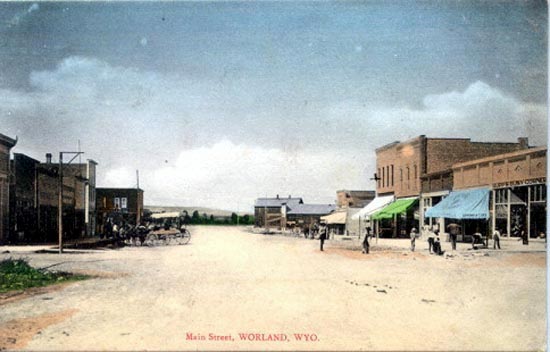 Big Horn Avenue, Worland, looking west, 1911. The pedestrians are crossing the street on the new concrete crosswalk installed in September, 1911. Mud in the streets was a continual problem. The Grit as late as 1927 complained that the mud in Big Horn Avenue was a foot thick. The Rupp's Busy Corner is the one-story building on the right. Down the street on the north side (right hand side of photo) were Herards Pharmacy and Jewelry, Russell Hardware, Hake Hardware, J. R. May's Dry Goods. The railroad depot is at the very end of the street on the right. On the opposite side of the street were the Stockgrowers Bank, the First National Bank (the first two not visible in photo), Worland Mercantile Co., E. M Conantran's clothing store, Mrs. M.C. Howell's Ladies' Furnishings. If undertaking services were required, instructions were left at Hake Hardware. Later, M. G. Wild opened a combination funeral parlor and piano and furniture store. Additionally, the Worland Furniture and Undertaking Company also provided arrangements.
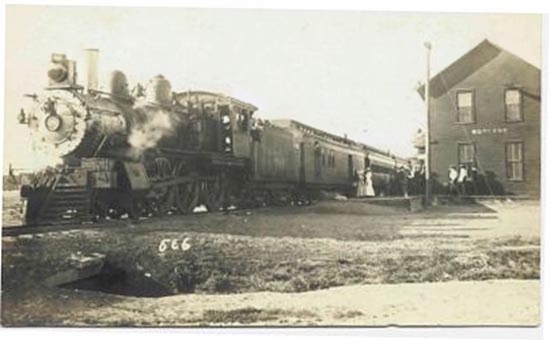 Worland depot, undated
Notwithstanding the first arrival of a train in July 1906, the Worldand Grit on February 14, 1907, felt, perhaps tongue in cheek, that it was newsworthy that several times during the previous week the passenger train arrived on the day that it was due. Other than by train, transportation into the town remained problematical. At first getting to the east side of the river was either by a ferry or a foot bridge. In October, 1906, the Grit reported that the ferry was opened. The ferry, however, did not operate in the winter or when there was high water. Thus before the ice was solid, crossing the river was an adventure. In August, 1908, as an example, Herb Horel's team drowned when he attempted to ford his rig across the river. Horel (1878-1959) came to Wyoming about 1902 as a trapper. Later he became a stockman and county commissioner. In Febuary, 1908, the Masonic Lodge was instituted and the following month the Odd Fellows Lodge was formed. The following year, efforts were made to organize a Brotherhood of American Yeomen lodge. By 1909, a bridge was opened over the river. The same year, surveying for a proposed road to Ten Sleep began. The Road eastward across the Big Horns, however, was not completed until 1922 and was not made "all weather" Roads remained to a great extent a community affair with an annual "Good Roads Day" at which citzens with shovels would work on the roads. The State Prison would also loan prisoners to work on the roads. One was George Sabin convicted for his part in the Spring Creek Raid. He escaped but the guard did not report him missing for some 17 hours. Electricity did not arrive until 1913. But the power company was only operated at night. In 1914, the electric plant exploded and burned down. Thus, the company relied on the alfalfa mill to provide electricity. The arrangement proved not to be satisfactory. In 1916, the power company sued the alfalfa mill to force it to continue to sell electricity. The court ruled that it could not force the alfalfa mill to fire up its boilers to provide steam to the electric company. The result was that the manager of the electic company moved to Texas. The theatre put in its own generator so that movies could be shown on Tuesday and Friday nights. By August, 1916, a new owner of the electric company ordered new equipment. By 1917, the electricity was turned on during the daytime Tuesdays from 8:00 a.m. to 12:00 noon to permit use of electric irons. But even as late as 1921 electricity was generally available only from dark until midnight. Day service was available only on Mondays, Wednesdays and Saturdays starting at 7:00 a.m.
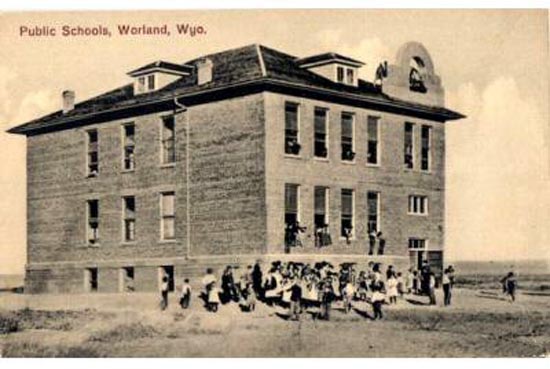 Worland Schools, approx. 1910. In 1920, an airplane flew over the City. By 1927 plans were announced for regular air service when Big Horn Airways acquired its first plane. Plans were made to clear the runway of sagebrush.
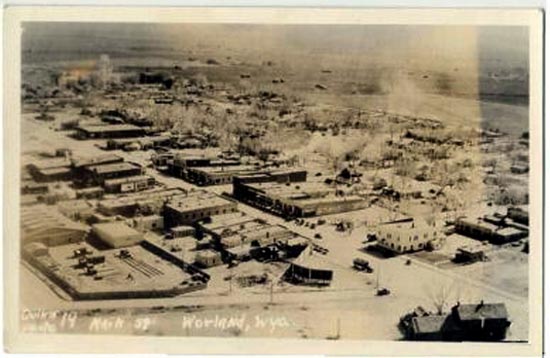 Aerial view of Worland, looking southeast.
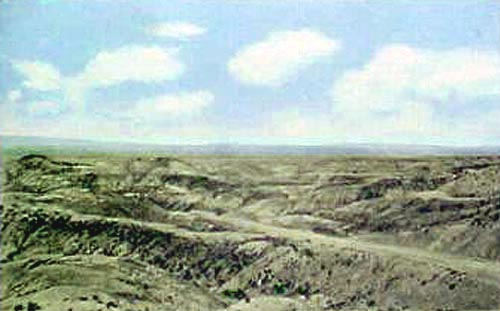 Worland-Ten Sleep Highway, 1920's. The condition of the main highways into the Basin was less than glorious. Henry S. Curtis in his 1918 Recreation for Teachers or the Teacher's Leisure Time recounts from the 1917 diary of two high school teachers and two instructors from the University of Colorado as they took the drive to Yellowstone. What now takes one day then took six days. Wednesday, August 8th. 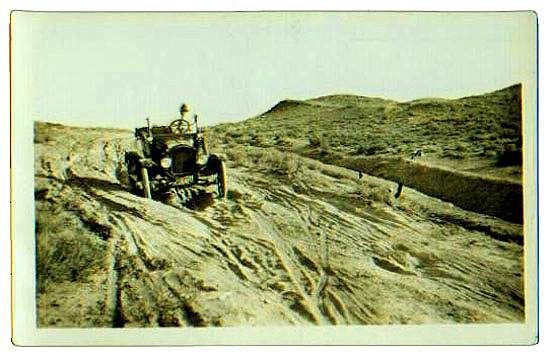 Highway near Basin c.1920.
Next page, Worland continued. |